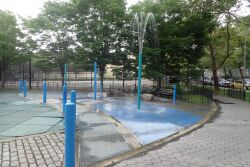Story Playground
Story Playground
Frame constitutions of government with what
wisdom and foresight we may, they must be
imperfect, and leave something to discretion,
and much to public virtue.
-Supreme Court Justice Joseph Story
Both Story Avenue and this playground honor legal scholar and Supreme Court Justice Joseph Story (1779-1845). Story was born in Marblehead, Massachusetts, to a prominent New England family. His father had taken part in the Boston Tea Party of 1773. Story attended Harvard College from 1795 to 1798 and graduated second in his class before going on to study law with an attorney from Marblehead. In 1801, Story was admitted to the Bar and began a successful practice in Salem, Massachusetts.
Story’s first wife, Mary Oliver, died in 1804, less than a year after their marriage. In 1808, Story wedded Sarah Wetmore, the daughter of a judge. Story advanced he career into politics, serving in the Massachusetts State Legislature (1805-1808), as Speaker of the Massachusetts House of Representatives, and in Congress (1808-1809). He abandoned party politics, however, after deciding that they required too great a sacrifice of ideals and individual opinion. In 1811, President James Madison (1751-1836) nominated him to the Supreme Court.
Story presided over some of the most important judgements in Supreme Court history. In the case of Martin v. Hunter’s Lessee (1816), Story argued that the Supreme Court had the authority to reverse the decisions of the state court when a constitutional question was involved. And in 1837 he wrote the dissent for the Charles River Bridge case, arguing for the sanctity of contracts.
Justice Story was instrumental in founding Harvard Law School in 1829. It swiftly became the model for university-based legal education throughout America. He authored a twelve-volume set of commentaries on American law, leading a later member of the Supreme Court, Oliver Wendell Holmes (1841-1935), to state that Story had “done more than any other English-speaking man in this century to make the law luminous and easy to understand.”
Story was a strong opponent of slavery, calling it “unnecessary, unjust, and inhuman, repugnant to the general principles of justice and humanity.” Indeed his abolitionist beliefs were tested to their utmost in 1841, when the Supreme Court heard the case of the slave ship Amistad on which a group of Africans seized control of the craft as it carried them off the coast of Cuba. Story and the other members of the Supreme Court came under immense political pressure from the pro-slavery lobby, which included President Martin Van Buren (1782-1862), to rule that the “Amistads”, as the Africans were known, be returned to Cuba. However, the Supreme Court declared that the Amistads had been transported in violation of Spanish law and should thus be restored to their homelands in Africa. Speaking for the court, Story referred to “the eternal principles of justice” and “the ultimate right of all human beings in extreme cases to resist oppression.”
Aside from his work as a judge, Story had strong ideas about politics and religion. He believed that religion was necessary to the functioning of a peaceable society, yet doubted whether religion would remain a strong force when government did nothing to encourage it. He wrote, “It yet remains a problem to be solved in human affairs whether any free government can be permanent where the public worship of God, and the support of religion, constitute no part of the policy or duty of the state in any assignable shape.”
The city acquired Story Playground on May 8, 1958 and it opened for operation on July 9, 1962. Originally called P.S. 100 Playground, after the neighboring school, Commissioner Stern gave the park its current name on June 18, 1987.
Check out your park's Vital Signs
Clean & Safe
Green & Resilient
Empowered & Engaged Users
Share your feedback or learn more about how this park is part of a
Vital Park System








